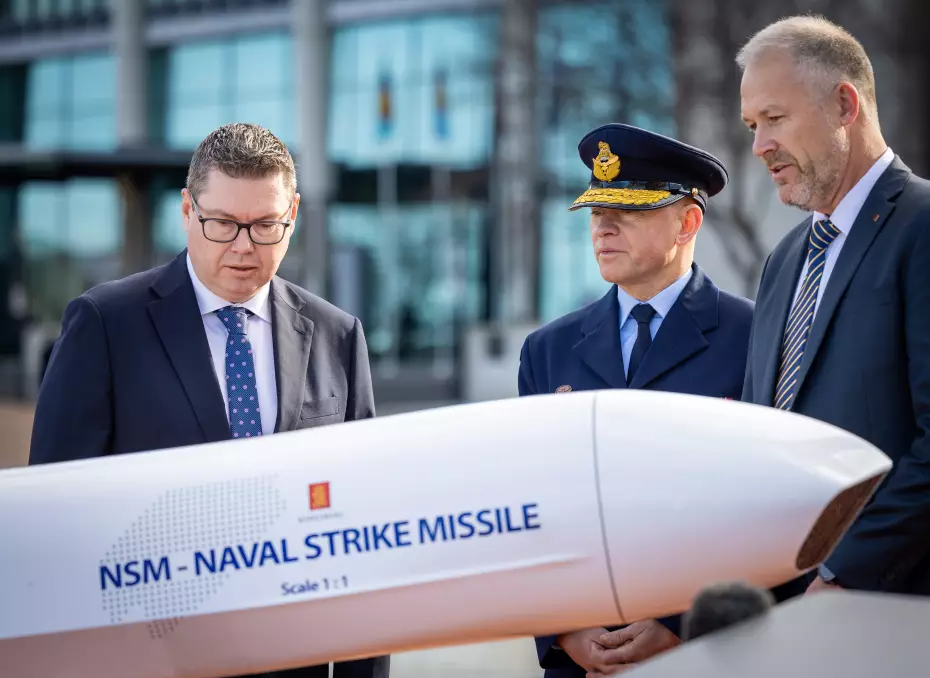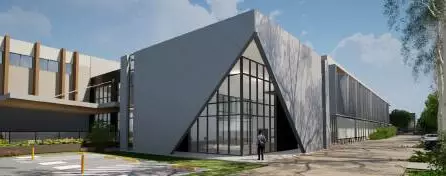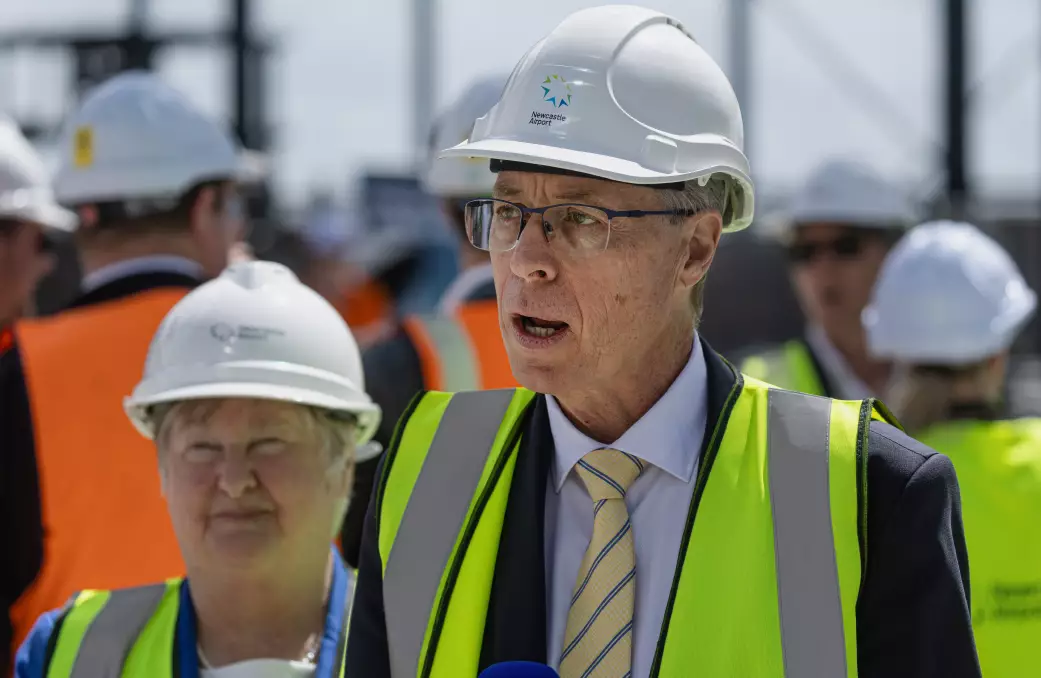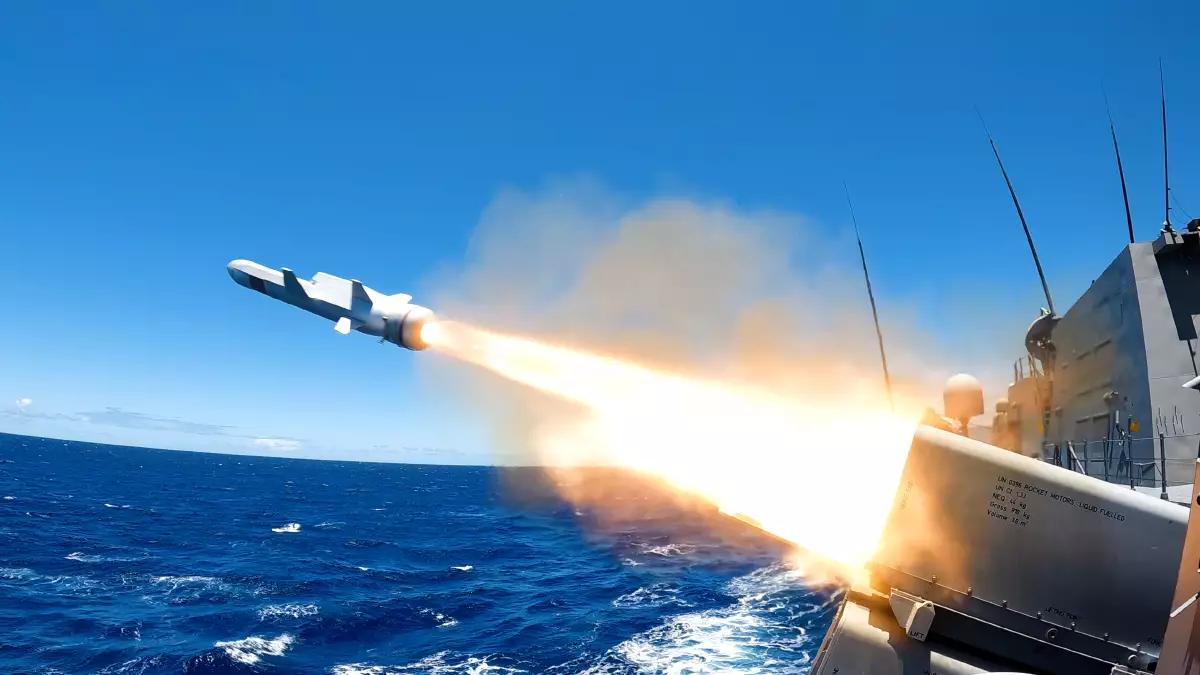Inside the top-secret missile factory deal Newcastle Airport ‘can’t afford’
By Donna Page
Updated November 9 2024 - 7:40am, first published 5:30am
📷 Minister for Defence Industry Pat Conroy in Canberra with the head of guided weapons and explosive ordnance Air Marshal Leon Phillips and Kongsberg Defence Australia general manager John Fry. Picture by Nicole Mankowski
THE Williamtown missile factory looked like a done deal.
From the minute a public announcement was made in August - by the Minister for Defence Industry Pat Conroy - it sounded like a done deal.
“Today, we are announcing an $850-million investment with Kongsberg Defence Australia to build an advanced guided weapons production facility right here in the Hunter Valley,” Mr Conroy said, on August 22.
And there was good reason to mark the occasion.
Mr Conroy said the Williamtown factory would create 500 construction jobs, inject $100 million into the Hunter’s economy and employ a further 100 people when it opened.
“The project, which involves construction of a factory in the Newcastle Airport precinct”, was “another example” of the Albanese government’s commitment to keeping Australians safe, he said.
And it wasn’t only the minister who was pushing the deal.
Newcastle Airport had already spent millions in unbudgeted funds hastily planning to build the new 9000-square metre missile factory.
Management was so confident, in fact, that staff were busy organising a December sod-turning ceremony at the site with Mr Conroy slated as the special guest of honour.
But an ongoing Newcastle Herald investigation can reveal that the factory has yet to obtain airport partnership board approval and is not funded.
While the deal was branded as an $850 million partnership between the federal government and Kongsberg - a move under which the Norwegian arms dealer will make more than 100 missiles a year at Williamtown - the reality for Newcastle Airport is very different, and much more complex.
Rightly or wrongly, missing from the August announcement was that Newcastle Airport has to borrow money for the construction of the $130 million factory in exchange for a long-term lease, which it hasn’t yet signed.
Also missing was the fact that the airport was facing serious insolvency concerns as its loss-making, property-development arm, Greater Newcastle Aerotropolis (GNAPL), increasingly drains cash reserves from the airport’s general operations (NAPL).
“Recent advancements in property projects have resulted in funding demands within the business surpassing the available sources of capital,” a May financial analysis of the airport reads.
It’s understood GNAPL recorded a loss of $5.4 million last financial year, which blew out from a budgeted loss of $2.5 million.
The previous financial year it lost $1.8 million, bringing accumulated losses this financial year to $14.1 million.
It resulted in the airport recording a loss of about $1 million last financial year.
📷 An artist’s impression of the proposed Kongsberg missile factory at Williamtown. Images supplied
As previously reported, the airport is facing a financial crisis due to cost blowouts on its terminal expansion, falling passenger numbers and unbudgeted expenditure for the Kongsberg factory and Lockheed Martin Air 65000 project.
Internal documents detail repeated warnings that the organisation is in financial trouble, has no clear plan to fund major projects and is fast running out of money - upgrading its financial management risk rating since February to “extreme”.
While Mr Conroy was spruiking the Kongsberg deal, insiders were left questioning why Williamtown was the centerpiece of the federal government’s announcement when the airport was unsure if it could even afford to build the factory.
They said it raises questions about who knew what and when, which remain unanswered.
“You have to question what is going on behind closed doors,” a staffer said. “You have to question why we want this so bad, when the airport’s finances are being drained to a point where it needs an equity bailout.”
A Defence spokesman said on Friday that the Commonwealth’s partnership with Kongsberg meant the factory would be built, but he declined to answer questions about the impact of the airport’s financial situation or its ability to fund the project.
In response to the growing controversy, Newcastle Airport’s board chair Jude Munro, outgoing CEO Peter Cock and part-owner City of Newcastle have scrambled to reassure the public that the airport is financially stable.
In stark contrast, the airport’s other part-owner, Port Stephens Council, remains tight-lipped and is refusing to answer questions.
An airport spokeswoman said on Friday that investments were being made to “yield long-term returns” and it could not answer questions about confidential or Defence-related issues.
“Stories based on misinformation can only hurt the Hunter region and the asset we operate for the benefit of the community,” she said.
The airport, Ms Munro and Dr Cock have been asked repeatedly to detail the misinformation in the Herald’s reporting but declined.
📷 Newcastle airport CEO Peter Cock and board chair Jude Munro.
But it’s the airport’s own internal documents which belie the ‘nothing-to-see-here’ defence being mounted.
A confidential paper submitted to last month’s GNAPL board meeting outlined the missile factory deal and added to the growing chorus of internal warnings about the financial risk.
“Based on … group forecasts there is insufficient headroom to fund unbudgeted capex from cash reserves, and in the event that CBA [Commonwealth Bank] debt funding is not obtained, there is expected to be a shortfall that would either breach the businesses $15 million working capital limit or require significant capital or operating cost savings to offset,” it reads.
The report goes on to say that funding from the Commonwealth Bank for the Kongsberg factory is “not likely to be approved and committed until 31 March 2025 at the earliest”.
Until then, GNAPL is reliant on a loan agreement with NAPL.
“Prior to the amendment of the CBA facility any funding required by GNAPL will be sought, subject to liquidity requirements, from NAPL,” the report reads.
While there appeared no doubt that the business case for the Kongsberg factory build was sound, internal documents reveal the risks are increasing as the airport’s cash reserves continue to be drained.
Despite the delicate financial balancing act, the GNAPL board appears undeterred. It recommended the factory plan for approval last month, including rubber-stamping additional costs of $2.631 million to advance the design and an extra $500,000 for planning.
This brings approved expenditure for the project to $5.731 million.
📷 The Royal Australian Navy test-fires a Kongsberg naval strike missile off the deck of HMAS Sydney near Hawaii. Picture by Daniel Goodman, ADF
There are now fears that what is seen as a “done deal”, could actually turn out to be a “dud deal” for the airport.
And yet it is being enthusiastically promoted, just as internal doubts about the airport’s finances continue to pile up.
“There is a tipping point and everything is pointing to the airport getting dangerously close to it,” an insider said. “We don’t have funding for the project and there is no signed lease yet. There is a lot of risk involved, but how widely was that known?”
On the positive side of the ledger, the board passed a vote last month to confirm the airport was solvent.
At the same meeting, however, it quietly issued airport management with a directive to accelerate documentation to allow cash injections from the councils, look at job cuts and investigate ways to allow the airport to dip below its required $15 million cash reserve limit.
“Review and reduce capital expenditure, including pausing board-approved projects…,” one directive reads.
“Develop a plan to reduce labour costs including enacting a freeze on hiring and staff rationalisation plan … Accelerate documentation of the working capital facility with CBA [Commonwealth Bank] to enable shareholder funding.”
Another says review the $15 million “working capital floor and recommend to the board the parameters that require a temporary reduction”.
Vexed staff are now asking questions about why the airport would “aggressively pursue” the missile factory as it investigates ways to access a multimillion-dollar bailout of ratepayer funds, because the airport is struggling under a mountain of debt.
“Among all the things that weren’t said at the time of the Kongsberg announcement was it was highly questionable if the airport could afford to build the thing,” one said.
The Herald has previously reported that a funding injection from the councils would require approval from Local Government Minister Ron Hoenig.
But a July document details the airport investigating ways around the requirement.
“Potential shareholder funding options continue to be evaluated,” it reads. “Focus on alternatives that do not require ministerial approval…”
These include “monetisation of land value via sale and long-term lease back to shareholder councils” and establishing a working capital facility that would see Newcastle Airport issuing bills of exchange, to be accepted by the Commonwealth Bank, but funded by the councils.
The deadline is looming for the ultimate decision-making authority within the airport’s complicated structure, which is controlled by the two councils.
The Greater Newcastle Aerotropolis Partnership Board, whose final approval is needed for the missile factory to proceed, is expected to meet later this month.
It is made up of City of Newcastle CEO Jeremy Bath and Labor councillor Nuatali Nelmes, plus Port Stephens mayor Leah Anderson and general manager Tim Crosdale. Port Stephens council also nominates a councillor and manager to the board for extra oversight.
The lack of transparency and confusion throughout the process has only encouraged scepticism from those inside the airport.
“We’re facing job cuts and it looks like we’re going to approve a massive building project that we can’t afford right now,” they said.
“The whole thing just boggles the mind.”
Do you know more? Donna.page@newcastleherald.com.au
“You have to question why we want this so bad, when the airport’s finances are being drained to a point where it needs an equity bailout”
- Airport staffer






